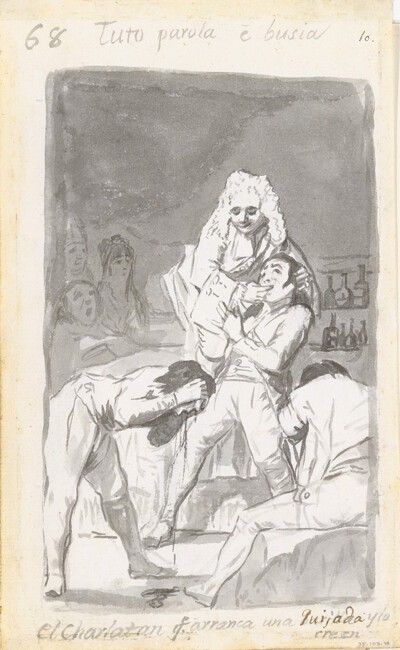- Cronología
- Ca. 1797 - 1799
- Dimensiones
- 219 x 152 mm
- Técnica y soporte
- Aguafuerte, aguatinta bruñida, punta seca y buril
- Reconocimiento de la autoría de Goya
- Undisputed work
- Ficha: realización/revisión
- 12 Dec 2010 / 29 May 2024
- Inventario
- 225
Al Conde Palatino. (at the bottom)
33. (in the upper right-hand corner)
See Francisco de Goya y Lucientes, Painter.
A state proof survives with the handwritten inscription, The Count Palatine. The engraver probably misread and put "Al" instead of "El", so the final title is Al Conte Palatino.
The preparatory drawing for this engraving is in the Metropolitan Museum of Art, New York.
An elegant man dressed in luxurious clothes, wearing a wig and a chain around his neck, is pulling out the tooth of another whose face is distorted by the pain. In the foreground, on the left, another bent over is vomiting, while on the right a person sitting with his back bent over is also a victim of this peculiar dentist's methods. Behind the latter, on a piece of furniture, one can see all sorts of bottles of drugs that he applies to his patients.
The figure who is having a tooth pulled out is the one on whom Goya worked most carefully, using the drypoint for the parallel lines of his shirt and legs. With the use of aquatint he obtained a light tone in the foreground and a medium tone in the background. He has also left a few reserves of varnish for the flasks and bottles on the piece of furniture in the background.
The manuscript in the Prado Museum clearly explains engraving no. 33, about which the following is said: "In all sciences there are charlatans who, without having studied the word, know everything and find a remedy for everything. Do not trust what they say. The true sage is always suspicious of accuracy: he promises little and delivers much; but the Count Palatine does not deliver anything of what he promises".
Goya denounced the practices of all those who claimed to be able to solve certain health problems, but in the end caused nothing but inconvenience. The Aragonese painter calls for scientific knowledge based on a thorough training that would enable us to deal with this type of circumstances with a certain foundation.
The most difficult part of the interpretation of this engraving is the identity that could be hidden behind the name of Count Palatino. Perhaps it refers to the minister Mariano Luis de Urquijo (Bilbao, 1769-Paris, 1817) known for his repressive governmental system and the famous ostentation of his toilette. It has also been thought that the painter was alluding to Count Cagliostro (Palermo, 1743-Urbino, 1795), an occultist and physician who was sentenced to life imprisonment and ended his days in the dungeons of the castle of San Leon in the marchiggiana town of Urbino.
The plate is in a poor state of preservation with the aquatint quite weakened and the drypoint details missing (National Chalcography , no. 204).
-
Goya. Gemälde Zeichnungen. Graphik. TapisserienKunsthalle BaselBasle1953from January 23th to April 12th 1953cat. 223
-
De grafiek van GoyaRijksmuseum RijksprentenkabinetAmsterdam1970from November 13th 1970 to January 17th 1971cat. 31
-
Goya. Das Zeitalter der Revolucionen. Kunst um 1800 (1980 – 1981)Hamburger KunsthalleHamburg1980cat. 55
-
Goya. La década de Los CaprichosMadrid1992organized by Real Academia de Bellas Artes de San Fernando sponsored by Fundación Central Hispano, Madrid, consultant editor Nigel Glendinnig. From October 26th 1992 to January 10th 1993cat. 105
-
Francisco Goya. Sein leben im spiegel der graphik. Fuendetodos 1746-1828 Bordeaux. 1746-1996Galerie KornfeldBern1996from November 21st 1996 to January 1997cat. 39
-
Francisco de GoyaMuseo d'Arte ModernaLugano1996exhibition celebrated from September 22nd to November 17th.cat. 33, p.60
-
Francisco Goya. Capricci, follie e disastri della guerraSan Donato Milanese2000Opere grafiche della Fondazione Antonio Mazzottap.29, cat. 33
-
Goya e la tradizione italianaFondazione Magnani RoccaMamiano di Traversetolo (Parma)2006consultant editors Fred Licht and Simona Tosini Pizzetti. From September 9th to December 3th 2006cat. 33, p.154
-
Goya. Opera graficaPinacoteca del Castello di San GiorgioLegnano2006exhibition celebrated from December 16th 2006 to April 1st 2007p.32
-
Goya et la modernitéPinacothèque de ParisParís2013from October 11st 2013 to March 16th 2014cat. 154
-
Goya engravings and lithographs, vol. I y II.OxfordBruno Cassirer1964pp.104-105, cat. 68
-
Vie et ouvre de Francisco de GoyaParísOffice du livre1970p.180, cat. 517
-
Goya, la década de los caprichos: dibujos y aguafuertesMadridReal Academia de Bellas Artes de San Fernando1992pp.178-181, cat. 104-106
-
Catálogo de las estampas de Goya en la Biblioteca NacionalMadridMinisterio de Educación y Cultura, Biblioteca Nacional1996p.91, cat. 122
-
El libro de los caprichos: dos siglos de interpretaciones (1799-1999). Catálogo de los dibujos, pruebas de estado, láminas de cobre y estampas de la primera ediciónMadridMuseo Nacional del Prado1999pp.196-199
-
ParísPinacoteca de París2013p. 219
-
Goya. In the Norton Simon MuseumPasadenaNorton Simon Museum2016pp. 42-75

